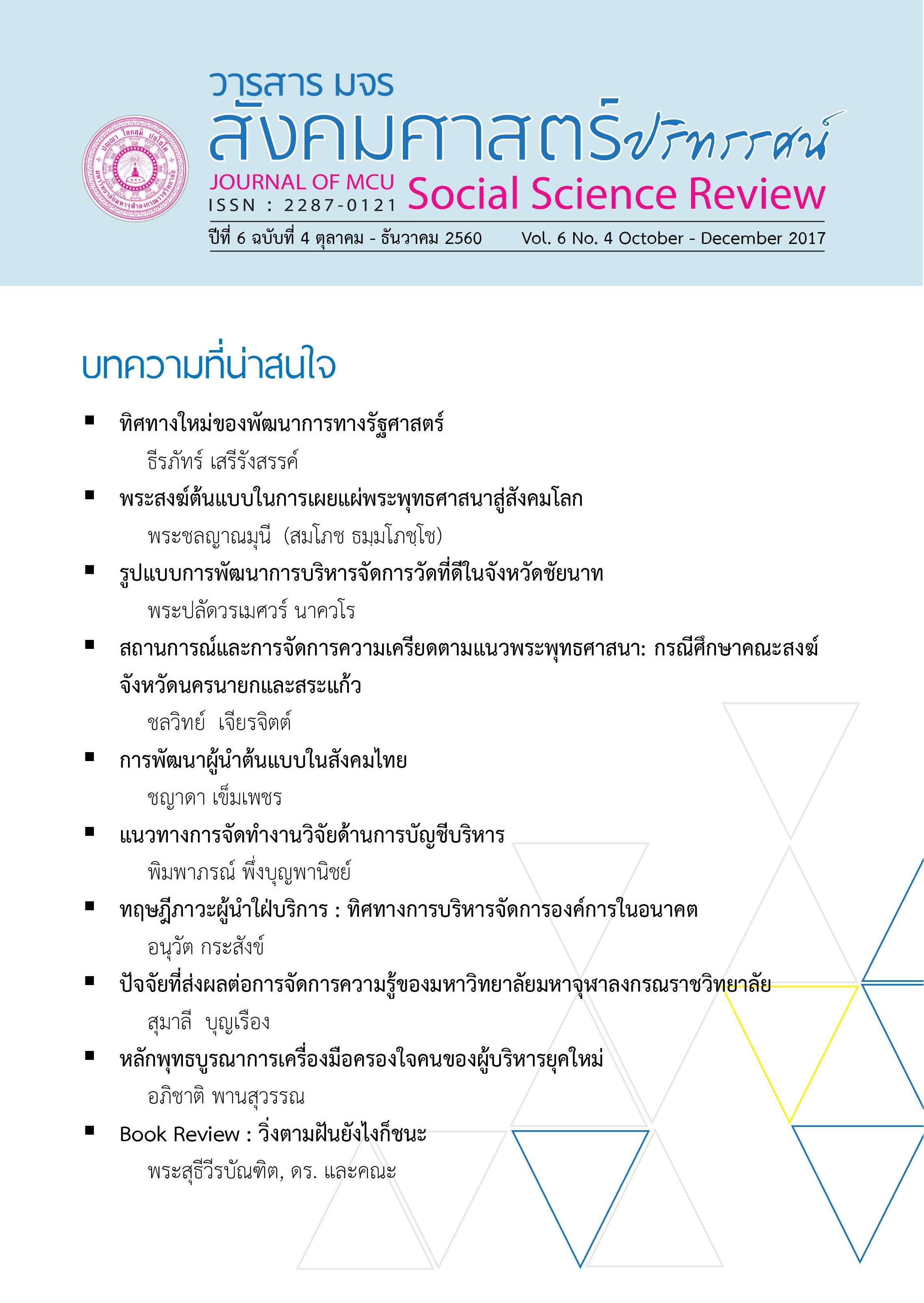สถานการณ์และการจัดการความเครียดตามแนวพระพุทธศาสนา: กรณีศึกษาคณะสงฆ์จังหวัดนครนายกและสระแก้ว
คำสำคัญ:
การจัดการความเครียด, หลักธรรมกับความเครียดบทคัดย่อ
บทความเรื่อง “สถานการณ์และการจัดการความเครียดตามแนวพระพุทธศาสนา: กรณีศึกษาคณะสงฆ์จังหวัดนครนายกและสระแก้ว” มีวัตถุประสงค์การศึกษา ได้แก่ 1) เพื่อวิเคราะห์สถานการณ์และการจัดการปัญหาความเครียดของพระสงฆ์จังหวัดนครนายกและสระแก้ว 2) เพื่อวิเคราะห์หลักธรรมและกระบวนจัดการความเครียดตามแนวพระพุทธศาสนา และ 3) เพื่อเสนอแนวทางการจัดการความเครียดตามแนวพระพุทธศาสนาที่สอดคล้องกับบริบทสังคมสมัยใหม่ การศึกษาครั้งนี้เป็นการวิจัยเชิงผสมผสาน โดยการวิจัยเชิงปริมาณเก็บแบบสำรวจจากพระสงฆ์ที่สังกัดวัดในจังหวัดนครนายกและสระแก้ว กำหนดกลุ่มตัวอย่างโดยใช้ Taro Yamane จำนวน 262 รูป เพื่อให้สามารถวิเคราะห์สถานการณ์และการจัดการปัญหาความเครียดของพระสงฆ์จังหวัดนครนายกและสระแก้ว ขณะที่การวิจัยเชิงคุณภาพมุ่งเน้นการสัมภาษณ์จากกลุ่มผู้ให้ข่าวสำคัญ ทั้งพระสงฆ์และนักวิชาการด้านพระพุทธศาสนาจำนวน 15 รูป/คน และยังมีการจัดสัมมนากลุ่มย่อยและการสัมมนาเชิงปฏิบัติเพื่อให้ได้ข้อเกี่ยวกับแนวทางการจัดการความเครียดตามแนวพระพุทธศาสนาร่วมด้วย
ผลการศึกษาพบว่า ประการที่หนึ่งสถานการณ์และการจัดการปัญหาความเครียดของพระสงฆ์จังหวัดนครนายกและสระแก้ว ปัจจัยที่นำไปสู่ความเครียดของกลุ่มตัวอย่างพระสงฆ์จังหวัดนครนายกและจังหวัดสระแก้วคือการมีความรู้สึกกังวลหรือมีปัญหาต้องให้แก้ไขอยู่เป็นประจำ รองลงมาคือ รู้สึกต้องแบ่งเบาภาระความเครียดจากคนรอบข้างประสบปัญหาความเครียด อันดับที่สาม คือกังวลต่อปัญหาสุขภาพของตนเอง จึงจะเห็นได้ว่ามีความจำเป็นที่จะต้องพัฒนากระบวนการเรียนรู้ร่วมกันของพระสงฆ์ที่ทำหน้าที่บริหารจัดการองค์กรทางพระพุทธศาสนา เพื่อให้เข้าใจแนวทางการจัดระบบงาน มีการแบ่งเบาภาระร่วมกัน ตลอดจนเปิดโอกาสให้ฆราวาสสามารถเข้ามาร่วมทำกิจกรรมทางพระพุทธศาสนาได้มากยิ่งขึ้น ประการที่สองหลักธรรมและกระบวนจัดการความเครียดตามแนวพระพุทธศาสนา มีหลักธรรมที่สำคัญ 4 หลักธรรมกล่าวคือ 1) หลักไตรลักษณ์ 2) หลักอริยสัจ 4 3) หลักโยนิโสมนสิการ และ 4) หลักเจริญสติ ซึ่งมีจุดหมายร่วมกันคือการสร้างให้เห็นถึงเหตุแห่งทุกข์และการมองชีวิตให้ทะลุกถึงต้นตอของปัญหา เพื่อที่จะสามารถกำหนดแนวทางการแก้ไขปัญหาความเครียดได้อย่างถูกต้อง ไม่หลงไปกับการแก้ไขปัญหาความเครียดที่เพิ่มแต่กิเลสและมิจฉาทิฐิ แต่มุ่งให้ใช้กระบวนการเรียนรู้ทางพระพุทธศาสนา ซึ่งใช้สติและปัญญาเป็นเครื่องกำหนดการตัดสินใจในกระบวนการแก้ไขปัญหาความเครียดที่เกิดขึ้น และประการที่สามแนวทางการจัดการความเครียดตามแนวพระพุทธศาสนาที่สอดคล้องกับบริบทสังคมสมัยใหม่ คือการพัฒนาการเรียนรู้ การพัฒนาพื้นที่และการพัฒนากิจกรรมทางพระพุทธศาสนา ให้เกิดขึ้นในพื้นที่ของวัดและชุมชนที่ใกล้เคียง โดยมีเป้าหมายสำคัญที่การพัฒนาแนวทางการดำเนินวิถีชีวิตให้พระสงฆ์ สามารถพัฒนาศักยภาพและการดำเนินงานให้สอดคล้องกับบริบทสังคมสมัยใหม่ อีกทั้งยังเป็นการเปิดโอกาสให้พระสงฆ์สามารถเรียนรู้กระบวนการพัฒนาสุขภาวะตนเองและฆราวาสได้
สำหรับข้อเสนอแนะการวิจัยที่สำคัญที่สองประการกล่าวคือ ประการที่หนึ่ง สำนักงานพระพุทธศาสนาจังหวัดนครนายกและสระแก้ว และสำนักงานสาธารณสุขจังหวัดนครนายกและสระแก้ว ควรพิจารณาจัดการตรวจสุขภาพเคลื่อนที่ให้กับพระสงฆ์ ทั้งในมิติสุขภาพกายและสุขภาพใจเพื่อเป็นฐานข้อมูลสำคัญของการยกระดับการดูแลสุขภาวะ และประการที่สองสำนักงานพระพุทธศาสนาแห่งชาติควรนำร่องนำแนวทางการจัดการปัญหาความเครียดตามแนวพระพระพุทธศาสนา ไปประยุกต์ใช้เพื่อการสำรวจสถานการณ์ปัญหาความเครียดของพระสงฆ์จังหวัดอื่นๆ เพื่อกำหนดทิศทางการแก้ไขปัญหาความเครียดให้เหมาะสมกับบริบทของสังคมและวัฒนธรรมต่อไป
เอกสารอ้างอิง
James George Frazer. (1926). The Golden Bough. London: Dover Publications Inc.
Margaret Lock. (1993). Encounter with Aging, Mythologies of Menopause in Japan and North America. Los Angeles and London: University of California Press.
Michel Foucault. (1973). Madness and Civilization: A History of Insanity in The Age of Reason. New York: Vintage Books.
____________. (1975). The Birth of the Clinic; An Archaeology of Medical Perception. New York: Vintage Books.
Pannathorn Chachavarat. (2010). Factors Affected to Health Behavior Among Monks in Muang District, Phayao. Phayao: Boromarajonnani College of Nursing.
Paul Famer. (1992). AIDS and Accusation: Haiti and the Geography of Blame. Los Angeles, and Oxford: University of California Press.
Phra Narong Sangkhawichit. “Administration: Problems and Suggested Solutions”. Journal of MCU Social Science Review. 6(1), 27-40
Phramaha Suthit Oboun. (2016). Sustainable Community Happiness Indicators. Bangkok: Learning and Empowerment for Healthy Communities Institute.
Phramaha Udom Nupan. (2007). Stress from Studying of Monks and Novices in The Pali Ecclesiastical Education of The Central Region. Thesis of Master of Arts. Graduate School, Silpakorn University.
Prawase Wasi. (2016). Buddhism is a Capital of Thailand Society. Bangkok: Offset Plus.
Somyot Ruksakeaw. Development of Behavioral Morality Model for Students in Primary Schools Under The Office of Primary Educational Area in Upper Southern Part of Thailand. Journal of MCU Social science Review. 6(1), 303-312.
ดาวน์โหลด
รูปแบบการอ้างอิง
ฉบับ
ประเภทบทความ
สัญญาอนุญาต
ลิขสิทธิ์ (c) 2017 วารสาร มจร สังคมศาสตร์ปริทรรศน์

อนุญาตภายใต้เงื่อนไข Creative Commons Attribution-NonCommercial-NoDerivatives 4.0 International License.
เพื่อให้เป็นไปตามกฎหมายลิขสิทธิ์ ผู้นิพนธ์ทุกท่านต้องลงลายมือชื่อในแบบฟอร์มใบมอบลิขสิทธิ์บทความให้แก่วารสารฯ พร้อมกับบทความต้นฉบับที่ได้แก้ไขครั้งสุดท้าย นอกจากนี้ ผู้นิพนธ์ทุกท่านต้องยืนยันว่าบทความต้นฉบับที่ส่งมาตีพิมพ์นั้น ได้ส่งมาตีพิมพ์เฉพาะในวารสาร มจร สังคมศาสตร์ปริทรรศน์ เพียงแห่งเดียวเท่านั้น หากมีการใช้ภาพหรือตารางหรือเนื้อหาอื่นๆ ของผู้นิพนธ์อื่นที่ปรากฏในสิ่งตีพิมพ์อื่นมาแล้ว ผู้นิพนธ์ต้องขออนุญาตเจ้าของลิขสิทธิ์ก่อน พร้อมทั้งแสดงหนังสือที่ได้รับการยินยอมต่อบรรณาธิการ ก่อนที่บทความจะได้รับการตีพิมพ์ หากไม่เป็นไปตามข้อกำหนดเบื้องต้น ทางวารสารจะถอดบทความของท่านออกโดยไม่มีข้อยกเว้นใดๆ ทั้งสิ้น





